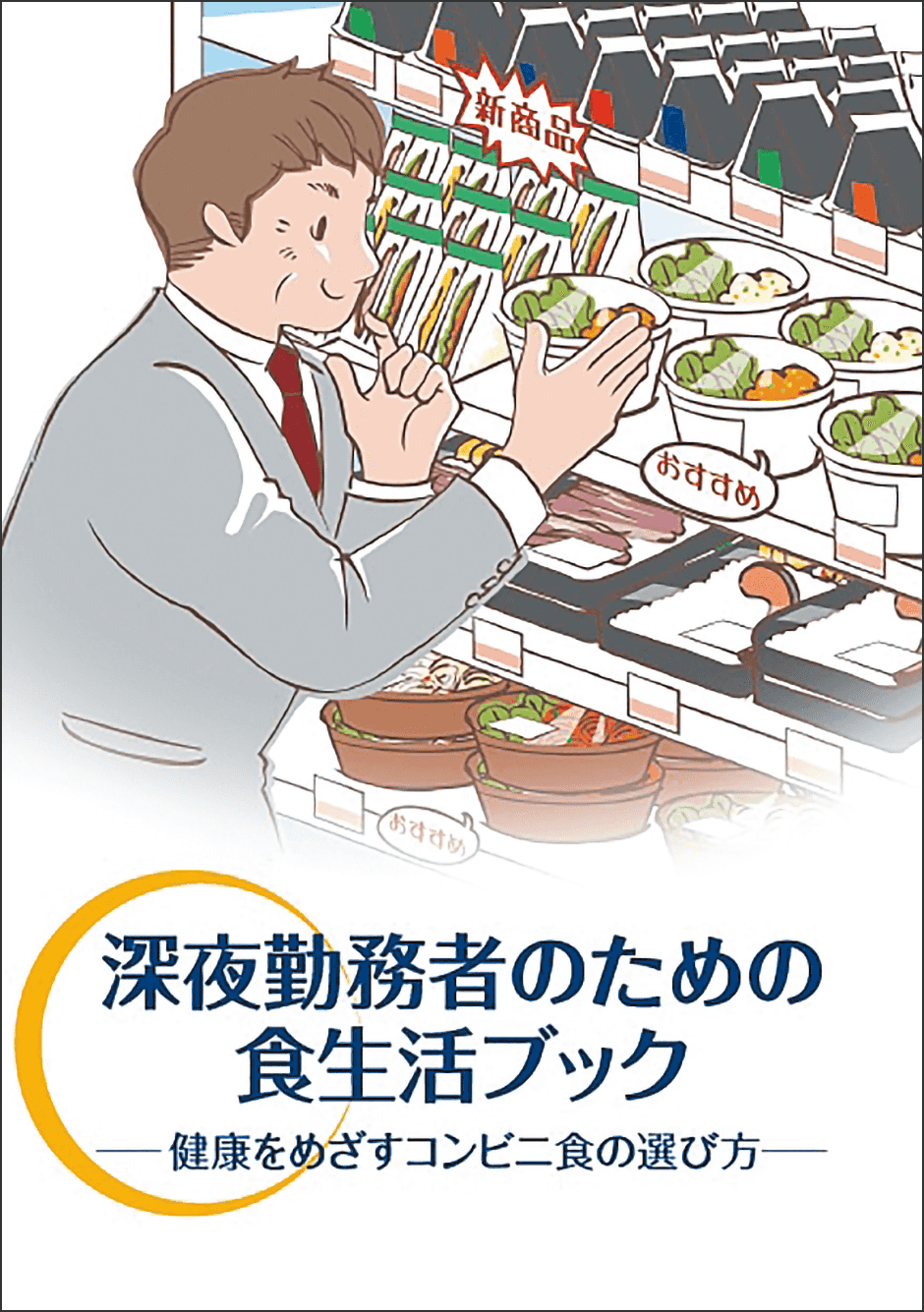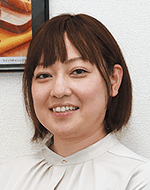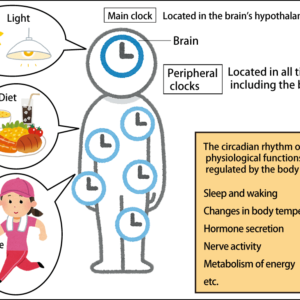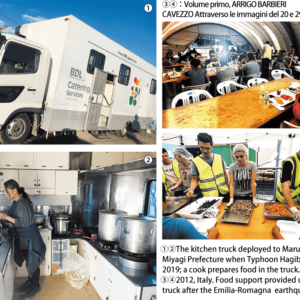We all know that a well-balanced diet is important, but our nutritional balance inevitably tends to become skewed. At times such as these, the nutrition facts labels on convenience store meals are actually a great help. Checking these labels makes it easier to control our intake of sugar and salt, among others. At the same time, elderly people with lifestyle-related diseases or longstanding conditions have to be even more careful about nutrition. One way of dealing with such situations is to leave nutritional management in the hands of meal delivery services offering convalescent foods and nursing care foods.
Special Feature 1 – Nutritional Science for a New Age Convenience store meals and convalescent foods for a healthy life expectancy
text by Takakazu Kawasaki
The Research Center for the Promotion of Health and Employment Support (https://www.tokyor.johas.go.jp/) at Tokyo Rosai Hospital (Ota-ku, Tokyo) published a booklet called Shin’ya Kinmu-sha no tame no Shoku Seikatsu Handobukku [The Diet Book for Night Shift Workers: How to Choose Healthy Convenience Store Meals] (2016), which has subsequently become very popular. The booklet was produced by Yoshie Hirasawa, a national registered dietitian and support coordinator at the center.

The booklet produced by Yoshie Hirasawa (available on the Tokyo Rosai Hospital website).
Even convenience store menus offer nutritionally balanced options
“I produced this booklet based on a survey of lifestyle habits and diet among shift workers and people who work at night, which I conducted between 2013 and 2016,” Ms. Hirasawa says. “I have been involved in providing nutritional guidance to taxi drivers for almost 20 years. They work shifts around the clock and if they needed to eat a meal late at night, the only restaurants open were those specializing in ramen noodles or beef bowls. Even if they opted for convenience store meals, these tended to be simple items like rice balls, sandwiches, and snack breads, so many of these drivers failed to eat enough vegetables and consumed too much salt.
Spending long hours behind the wheel also meant that they tended to lack sufficient exercise and the results of my survey showed that many of them had findings indicative of lifestyle-related diseases such as high blood pressure and diabetes. On the dietary side, it became clear that the average taxi driver ate two rather than three times a day, with only one of those meals including vegetables, and 70% of the taxi drivers purchased their food for consumption late at night at convenience stores. Even people reliant on convenience stores can increase their vegetable intake and control portion size by making appropriate choices. As exercising some creativity in one’s choices makes it possible to achieve a better nutritional balance, I decided to give my research findings concrete form by producing this booklet,” she says.

Figure 1. Nutritional analysis of convenience store mealsThe “anpan and instant noodles” meal and the “deep-fried cutlets and prawns bento” are commonly chosen by men, but lack vitamins and minerals. Rice ball and salad is a combination commonly chosen by women, but lacks almost all nutrients. Adding a tuna salad to the spaghetti with meat sauce ensures a good balance.
As shown in Figure 1, of the meals commonly eaten by men, a meal of anpan (sweet roll filled with red bean paste) and instant noodles is high in energy, cholesterol, and carbohydrates, but lacking in vitamins, dietary fiber, and potassium. This tendency is even more pronounced in hearty bento box meals, in which the principal item is some form of deep-fried food. Women often choose a rice ball and salad, but this combination is almost completely lacking in nutrients.
However, even at a convenience store, you can get almost all the nutrients you need without consuming excessive calories if you choose pasta with meat sauce and add a tuna salad to it.
In particular, continually eating meals that contain excessive energy and a poor nutritional balance, as is often the case among men, can have an adverse impact on the body.
“I visit companies to provide nutritional counseling,” Ms. Hirasawa says. “At a company producing computer games, for example, quite a few of the staff members are obese, weighing more than 100 kg, despite being relatively young, in their 20s and 30s. In their medical check-ups, many of them have liver function results that exceed the standard values, even though they do not habitually drink alcohol, and many also have high uric acid levels.
They spend their working day sitting in a chair in front of a computer monitor, but do not exercise at all on their days off. They do their work at night and then even when they get home, they play their favorite games for a while before going to bed, so they get only three or four hours’ sleep a night and are chronically sleep-deprived. Some find their bodies cannot wake up in the mornings, so they consume drinks containing caffeine as a pick-me-up. Quite a few of these people complain of stomach problems due to the effects of this,” she says.
All convenience store meals have a nutrition facts label
Poor physical condition is closely related to diet. At present, there is a lack of interest in diet and nutrients, with people tending to eat at ramen stores and stand-up soba noodle bars near their workplaces, or get instant noodles and some kind of snack breads from a convenience store.
“I advise people on how to combine items available at convenience stores, including recommending that they eat green and yellow vegetables,” Ms. Hirasawa says. “And as there have recently been reports of a link between intestinal microbiota and obesity, I suggest drinking two lactobacillus drinks per day. Some people have found that their stomach problems have been alleviated and their physical condition has improved after a few months of following my advice.”
“The biggest advantage of convenience store meals is that they always have a nutrition facts label, which makes it easier to control one’s sugar and salt intake,” she says. “Some foods available in department store food halls and supermarkets don’t have them. These labels used to provide information about sodium content, which meant people had to work out the conversion to salt equivalent themselves, but now the labels actually show the salt equivalent, making it easier to understand one’s salt intake.”
In general, convenience store meals tend to include a lot of deep-fried (fatty) items and are heavily seasoned with salt or sugar. Ms. Hirasawa once asked someone at a convenience store food manufacturer whether they could reduce the salt content. They apparently replied, “We have to (heavily season the food) to make it last longer and ensure it appeals to everyone.” Due in part to greater health-consciousness among consumers, the quantity of vegetables is now increasing, while salt content is falling. Ms. Hirasawa hopes that consumers wishing to control their calorie or salt intake will make effective use of nutrition facts labels.
For example, if people concerned about high blood pressure use convenience store meals late at night or very early in the morning, a wise choice would be a combination of salmon rice ball and seaweed salad, providing 470 kcal of energy and 3.3 g of salt, or a nattō (fermented soybeans) sushi roll combined with avocado salad, providing 272 kcal and 2.5 g of salt. Both these combinations are designed with potassium intake in mind, while keeping salt at around the recommended intake of 3 g per meal.
If people concerned about dyslipidemia (triglycerides and LDL cholesterol) use convenience store meals late at night or very early in the morning, it is advisable to combine fatty blue-backed fish (such as sardines, mackerel, and herring ) rich in docosahexaenoic acid (DHA) and eicosapentaenoic acid (EPA) or protein-rich soybeans with seaweed or root vegetables containing an abundance of dietary fiber. For example, recommended combinations include a nattō sushi roll with seaweed salad (470 kcal, 3.3 g of salt) or flaked horse mackerel on rice with gomoku beans (soybeans boiled with carrot, burdock, lotus root and konnyaku) (400 kcal, 3.2 g of salt). When it comes to choosing snacks, nuts such as walnuts and almonds provide a lot more dietary fiber than snacks high in sugar or fat.
There are also healthy ways of eating.
“The vegetables-first approach, in which you eat your vegetables first, then your main dish, and then your rice or other staple dish, helps to minimize sharp rises in blood glucose levels,” Ms. Hirasawa says. “However, some vegetable juice products have the dietary fiber removed or contain added fruit juice or sugar, so may not be suitable as replacements for vegetables.”
Ms. Hirasawa has a recommendation about how to use convenience stores. “When choosing food at a convenience store, thinking about it as a meal —— that is to say, being conscious of striking a balance between your staple food, main dish, and side dishes —— helps in making healthier choices. Do give it a try,” she says.
Produced by a national registered dietitian under the supervision of a physician specializing in dementia prevention
However, nutritional management is difficult and time-consuming . It is particularly burdensome for elderly people with longstanding conditions and lifestyle-related diseases.
In such situations, one option is to use a meal delivery service that will take care of the nutritional management for you.
For example, the company Yoshikei Kaihatsu (head office: Shizuoka City), which serves approximately 500,000 users from Hokkaido to Okinawa Prefecture, provides daily deliveries (with free shipping) not only of meal kits, but also of frozen bento boxes and ready-cooked meals that just need heating in a microwave or double-boiler, with customers ordering weekly from a menu that offers a different meal every day. Of particular interest is the Wasai-goyomi menu range, which features meals that include items suited for use as convalescent foods and nursing care foods, inspired by the catchphrase “For adults who take their health seriously.” There are three options from which to choose: Premium, which includes many Japanese-produced ingredients and are all produced by a national registered dietitian, primarily under the supervision of a physician specializing in dementia prevention, Standard, and Light, which is suitable for people living alone, featuring meals that just need to be heated in a microwave or double-boiler.
“Most of the customers who are interested in the lower-calorie and lower-salt menus we offer are seniors and our Wasai-goyomi range is particularly popular with them.” So says Eri Kaneko, a national registered dietitian who heads Yoshikei Kaihatsu’s Menu Development Department. “We keep the weekly average salt content of these meals to no more than 2.8 g per meal (no more than 3.5 g per meal for the Light menus) and, except for the Light menus, they ensure that people can get almost half their recommended daily vegetable intake, providing at least 140 g of the 350 g target,” she explains.
Up to six days a week , Monday to Saturday, users receive a meal kit or ready-cooked meal for dinner and then prepare their own staple dish. Each day’s menu specifies the meal’s nutritional content in terms of energy, vegetables, sugar, carbohydrates, protein, fat, and salt equivalent (vegetable and sugar content is provided only for certain items).
“The primary ingredients in the main dishes are well balanced between beef, pork, chicken, and fish,” Ms. Kaneko says. “Each day’s meal consists of two to three dishes. Most of the ingredients are procured locally by 65 group companies across the country, in accordance with the menus developed by our head office.
When it comes to restricting salt intake, some customers feel that dishes lower in salt or soy sauce aren’t very tasty,” she continues. “So, to ensure they can enjoy their meals, we devise strategies like adding dried bonito flakes or other ingredients as appropriate to increase the umami in the meal. We also take care to add flavor to our menus using condiments such as green perilla, ginger, and sesame, so that users find them tastier.”
The Premium option in the Wasai-goyomi range is billed as “menus to support you in extending your healthy life expectancy” and includes two to three meals every week produced under the supervision of a physician.
For example, the Premium menu for the week Monday, November 16 through Saturday, November 21, 2020 (Figure 2) includes the following:
- 16th: Chikuzenni chicken and root vegetable stew; spinach and scrambled egg with a sweet vinegar dressing; aromatic rice with grilled shiitake mushrooms
- 17th: Soft pork loin with ginger sauce; maitake mushroom and root vegetable kenchin-jiru soup; julienned daikon radish with ume plum and mayonnaise dressing
- 18th: Grilled koji-marinated ginsei salmon; kasanemushi-style steamed pork and vegetables; sesame-roasted sweet potato
- 19th: Bulgogi-style miso beef; Korean-style deep-fried bean curd and mitsuba parsley salad.

Figure 2. An example of the Premium menu from Yoshikei Kaihatsu’s Wasai-goyomi rangeThe Wasai-goyomi range is popular with seniors interested in dishes with a lower calorie and salt content. Providing six evening meals a week, the menus feature a good balance between beef, pork, chicken, and fish in the main dishes and most specify the meal’s nutritional content in terms of energy, vegetables, sugar, carbohydrates, protein, fat, and salt equivalent.
Helpers are asked to cook in some cases
For those items requiring cooking, the menu book describes the cooking method and features color photographs of the finished items.
During this period, the cost was ¥1,390 – ¥1,610 for a two-person serving of the Premium menus, while the Standard option was priced at ¥880 – ¥1,120 for a two-person serving and the Light at ¥820 – ¥890 for a one-person serving.
“To make a meal, you have to go and buy the ingredients,” Ms. Kaneko notes. “The shopping bags are heavy and if you buy a whole cabbage, you end up eating cabbage-based meals every day, because you can’t eat the whole thing in a single meal. And now, many people aren’t going shopping because they want to avoid catching COVID-19. At a time like this, using our company is an option. Our staff will deliver to a place that’s convenient for the customer and if they aren’t available or want contactless delivery, we can lend them an ‘Anshin Box’ lockable delivery box to place outside their home,” she says.
Sachiko Yamazaki from Yoshikei Kaihatsu’s PR Strategy Office explains more about the advantages of meal delivery services.
“When a person goes shopping, they tend to buy the ingredients and dishes they prefer. But it’s healthier to eat as many different food types as possible,” she says. “Just the other day, someone living in the U.S. recommended our service to their parents in Japan, because COVID-19 prevented them from coming back to Japan for a visit and they were worried about their parents. There are also cases where seniors in need of nursing care who live alone use our meal delivery service and have their helpers cook for them.
In fact, as a dietitian, I myself was formerly involved in menu development for the company,” continues Ms. Yamazaki. “I didn’t have time to go shopping after finishing work, so I’d have our company’s meal delivery service deliver to my workplace and then would take everything home to cook dinner for my family.”
Now that people commonly reach the age of 100, we want to aim for healthy life expectancy. Food is absolutely crucial to achieving this.





















